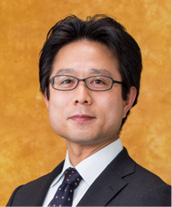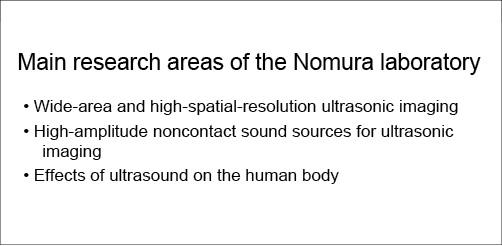
As of August, 2015
| Faculty/Department | Department of Communication Engineering and Informatics Graduate School of Informatics and Engineering |

|
| Members | Hideyuki Nomura, Associate professor | |
| Affiliations | Acoustical Society of Japan, Nonlinear Acoustics Society of Japan, Acoustical Society of America , Marine Acoustics Society of Japan, Institute of Electronics, Information and Communication Engineers, The Japan Society of Ultrasonics in Medicine | |
| Website | http://www.acelec.cei.uec.ac.jp/ | |
Acoust-electronics, Sounds, Ultrasounds, Ultrasonic measurements, Ultrasonic imaging, Ultrasonic exposure, Quality of life (QOL)
The Nomura laboratory deals with sound and vibration. Sounds are actually oscillations (longitudinal waves) propagating in air, water, or some other elastic medium. The sounds audible to humans are limited to some frequencies range (the number of oscillations per second is called the frequency). The sounds in the frequency range that humans can hear are called audible sounds or audible sound waves. The normal range of audible sounds in air is approximately 20 Hz to 20 kHz (one Hz is the frequency of a wave that oscillates once per second). Humans cannot hear sounds above 20 kHz. Sounds at frequencies higher than 20 kHz in air are usually called ultrasounds.
Electronic technologies have made it possible to generate and receive sounds and vibrations, and even analyze and process sound signals. Acoust-electronics is the general name for electronic technologies that deal with sounds and vibrations. Acoust-electronics are applied in many diverse fields (see Figure 1). Some examples of fields where ultrassounds are applied include ultrasonic bioimaging for medical engineering, ultrasonic rangefinders, and ultrasonic levitation.

The Nomura laboratory’s aim is to take full advantage of audible sounds and ultrasounds, as well as noise and vibrations, to improve quality of life (QOL) (see Figure 2).

The Nomura laboratory is presently engaged in main research areas (see Figure 3). One area is the development of technology for wide-area and high-spatial-resolution ultrasonic imaging. Another is the development of high-amplitude noncontanct sound source for applications in ultrasonic imaging and high power ultrasounds. The third area is analyses of the effects of ultrasounds on the human body.

Let’s briefly look at the present state of medical ultrasonic imaging. Medical ultrasonic imaging equipment takes cross-sectional images of living bodies. The range resolution of these images can be increased by raising the frequency of the ultrasounds. But the ultrasounds at high frequency are attenuated and absorbed by the viscosity of the medium, so that the ultrasounds cannot penetrate deeply into the body. For this reason, ultrasonic frequencies for medical imaging range between around 1 MHz and 20 MHz.
Lowering the ultrasonic frequency makes it possible to generate cross-sectional images deep into the body. The problem, however, is that lowering the ultrasonic frequency leads to the sounds spreading in the body. To solve this problem, the Nomura laboratory is introducing a technology called a parametric sound source (or parametric sound array) to generate directional low-frequency ultrasounds.
A parametric sound source sends is generated from the radiation of two intense ultrasonics in the same direction that are at slightly different frequencies. A sound at the different frequency of the two frequencies (the differential frequency component) is generated through the nonlinearity of the medium and shows a very narrow beam (see Figure 4). Thus, a low-frequency ultrasound generated by a parametric sound source penetrates deeply in a narrow area without spreading.

The difficulty is that the lower the ultrasonic frequency, the lower the range resolution, which makes the image resolution poorer. To overcome this problem, we are trying to increase the range resolution by applying pulse compression to the parametric sound echo signals.
Technology for high-amplitude, noncontact ultrasonic sources. In ultrasonic imaging, the source is normally placed in direct contact with the body surface. If there were an air gap between the source and the body, the ultrasounds would mostly reflect from the boundary. Therefore, the sound source is the need to place the surface of the body in direct contact. A gel-like substance is also placed in between to help better conduct the ultrasounds.
There are occasions, however, when we do not want the source to come in contact with the body - for instance, if there is a wound on the surface or if the gel coating feels unpleasant. Some innovation is needed in order to construct a virtual source on the body’s surface without contacting the surface.
The first idea to come to mind is an ultrasonic source shaped like a parabolic antenna. This is because ultrasounss from a parabola-shaped source can be focused on focused region in space to make efficient use of the ultrasonic energy.
The Nomura laboratory is studying a ultrasonic source that uses time-reversal acoustic waves. When a sound emitted from a transmitter is received by a microphone or sensor and then a time reversed signal is emitted from the microphone’s position, the sounds returns to the original source position. This is a time-reversal acoustic wave. Devices can be realized using this technology to converge sound waves on one point. For example, a sound source is placed in a box with a hole. The ultrasounds emitted from the source reflect multiply inside the box. The ultrasounds are received at the desired convergence point outside the box and the signal is reversed in time domain.
When this time-reversed signal is emitted form the source, a curious thing happens: ultrasounds are converged on the measured point. If the measurement point is on the surface of the body, the source of the ultrasound will be created virtually on the body’s surface.
As long as the measurement point is outside of the box, the point can be anywhere, in principle. Therefore, a virtual source can be constructed at any point by first measuring the sound and generating a time-reversal acoustic wave.
This section describes the effects of ultrasounds on the human body, especially ultrasonic exposure. Generally, ultrasounds are safe for the human body. On the other hand, there are reports of people feeling ill or developing headaches when standing in front of loudspeakers emitting high intense ultrasounds. Thus, there are lingering concerns that ultrasounds, although humans cannot hear them, do have some impact on the human body.
Furthermore, the effects may vary depending on the kind of ultrasonic exposure. For example, it is necessary for studies to separate out the effects of long exposures to weak ultrasonic waves and the effects of short exposures to strong ultrasonic waves. The Nomura laboratory is now looking into these matters from a theoretical and empirical standpoint.
[Interview and article by Akira Fukuda (PR Center)]